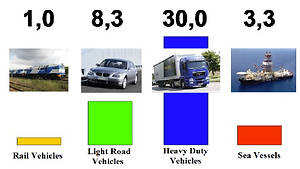Environmental aspects of rail vehicles with combustion engines
1
Poznań University of Technology
2
Rail Vehicles Institute „TABOR” in Poznań
Publication date: 2015-08-02
Rail Vehicles/Pojazdy Szynowe 2015,3,1-8
ABSTRACT
This paper covers the environmental issues related to the operation of rail vehicles.
The evaluation of the environmental impact is based in most cases on a comparison
of the current state of the internal combustion engine (its emissivity) with emission
limit values of harmful exhaust components. These values relate to specific emission
tests for engines or vehicles. For the national rail vehicles operating conditions
these requirements take a slightly different form, as having a wide range of rolling
stock markedly alters the environmental impact of these vehicles. Thus it becomes
necessary to consider the issue of the method of evaluation of engine emissions in
rail vehicles in terms of their actual operating conditions. Thus, efforts to assess the
actual level of emissivity for rail vehicles and attempts to improve it are necessary
and justified.
REFERENCES (13)
1.
Directive 2004/26/EC of the European Parliament and of the Council amending Directive 97/68/EC on the approximation of the laws of the Member States relating to measures against the emission of gaseous and particulate pollutants from internal combustion engines to be installed in non-road mobile machinery, 21.04.2004.
2.
ISO: Reciprocating internal combustion engines – exhaust emission measurement – Part 1: Test-bed measurement of gaseous and particulate exhaust emissions. Draft International Standard ISO/DIS 8178–1.2, 1995.
3.
Kettner J., Moving Towards Sustainable Mobility a Strategy for 2030 and Beyond for the European Railway Sector. 12 UIC Sustainability Conference, Venice 2012.
4.
Marciniak Z., Stawecki W., Merkisz J., Pielecha I., Pielecha J., Możliwości modyfikacji taboru spalinowego w celu zmniejszenia jego oddziaływania na środowisko naturalne. Technika Transportu Szynowego, 3, 2011, 43–48.
5.
Marciniak Z., Stawecki W., Pielecha I., Pielecha J., Ekologiczne aspekty spalinowych pojazdów szynowych eksploatowanych na krajowych liniach kolejowych. Logistyka, 4, 2010.
6.
Merkisz J., Pielecha J., Emissions and Fuel Consumption during Road Test from Diesel and Hybrid Buses under Real Road Conditions. IEEE Vehicle Power and Propulsion Conference (VPPC’10), Lille 2010.
7.
Merkisz J., Pielecha J., Nanoparticle Emissions from Combustion Engines. Springer Tracts on Transportation and Traffic, 8, 2015.
8.
Merkisz J., Pielecha J., Fuć P., Emissionsfaktoren aus PEMS-basierter RDE-Prüfung für Fahrzeuge aller Gewichtklassen/ LDV and HDV vehicle exhaust emission indexes in PEMS-based RDE tests. Fortschritt-Berichte VDI. Rheine 12, Nr 783, Vol. 1, 240–265.
9.
Merkisz J., Pielecha J., Gis W., Exhaust Emission Results from Light Duty Diesel in a Road Tests. Automobiles and Sustainable Mobility, FISITA 2010 World Automotive Congress, F2010-A-045. Scientific Society for Mechanical Engineering (GTE), Budapest 2010.
10.
Merkisz J., Pielecha J., Radzimirski S., New Trends in Emission Control in the European Union. Springer Tracts on Transportation and Traffic, 1, 2014.
11.
Norma PN-EN ISO 8178-4, Silniki spalinowe tłokowe. Pomiar emisji spalin. Cykle badawcze silników o różnym zastosowaniu. Wyd. 1999.
12.
Pielecha I. Marciniak Z., Wpływ silników spalinowych pojazdów trakcyjnych eksploatowanych w kraju na środowisko – próby i badania oraz wytyczne dla redukcji emisji składników szkodliwych. Pojazdy Szynowe, 1, 2009, 34–43.
13.
Pielecha I., Pielecha J., Tendencje w przepisach dotyczących emisji związków toksycznych przez silniki spalinowe pojazdów szynowych. Pojazdy Szynowe, 1, 2005, 52–59.
We process personal data collected when visiting the website. The function of obtaining information about users and their behavior is carried out by voluntarily entered information in forms and saving cookies in end devices. Data, including cookies, are used to provide services, improve the user experience and to analyze the traffic in accordance with the Privacy policy. Data are also collected and processed by Google Analytics tool (more).
You can change cookies settings in your browser. Restricted use of cookies in the browser configuration may affect some functionalities of the website.
You can change cookies settings in your browser. Restricted use of cookies in the browser configuration may affect some functionalities of the website.



